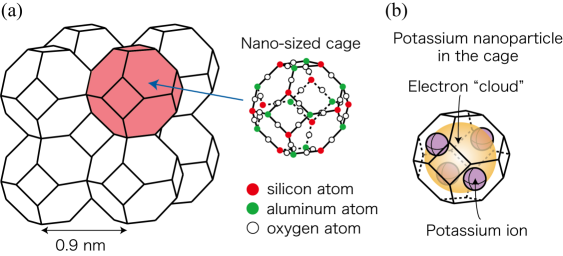Schematic illustration of (a) porous crystal of sodalite with nano-sized cage and (b) potassium nanoparticle formed in the cage. An electron “cloud” is shared among four potassium ions. Mössbauer spectroscopy was performed by using a synchrotron-radiation light of SPring-8, which was adsorbed by the potassium nucleus at the center of the ion. The obtained data directly evidence that the electron “cloud” in the nanoparticle is the origin of the magnetism in this material.
Successful Observation of Mössbauer Absorption of Potassium Nucleus by Using Synchrotron Radiation
A research group led by Takehito Nakano (Assistant Professor, Graduate School of Science, Osaka University), Makoto Seto (Professor, Research Reactor Institute, Kyoto University), and Yoshitaka Yoda (Principal Researcher, Japan Synchrotron Radiation Research Institute) succeeded in observing Mössbauer absorption spectra of potassium nucleus by using a synchrotron-radiation light source for the first time. They clarified the origin of an exotic magnetic property of a periodic array of potassium metal nanoparticles in a porous crystal. The experimental technique is applicable to any kinds of materials containing the abundant element potassium, and will be a powerful tool in various scientific fields such as physics, chemistry, materials science, biology, and earth science to investigate the local environment of the atoms in the condensed matter.

(Link) http://resou.osaka-u.ac.jp/en/research/2015/20150406_1











